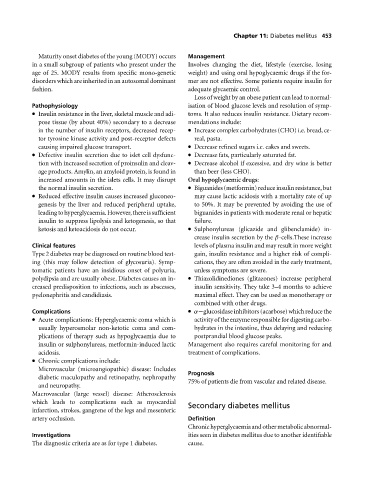Page 457 - Medicine and Surgery
P. 457
P1: FAW
BLUK007-11 BLUK007-Kendall May 25, 2005 8:5 Char Count= 0
Chapter 11: Diabetes mellitus 453
Maturity onset diabetes of the young (MODY) occurs Management
in a small subgroup of patients who present under the Involves changing the diet, lifestyle (exercise, losing
age of 25. MODY results from specific mono-genetic weight) and using oral hypoglycaemic drugs if the for-
disorders which are inherited in an autosomal dominant mer are not effective. Some patients require insulin for
fashion. adequate glycaemic control.
Loss of weight by an obese patient can lead to normal-
Pathophysiology isation of blood glucose levels and resolution of symp-
Insulin resistance in the liver, skeletal muscle and adi- toms. It also reduces insulin resistance. Dietary recom-
pose tissue (by about 40%) secondary to a decrease mendations include:
in the number of insulin receptors, decreased recep- Increase complex carbohydrates (CHO) i.e. bread, ce-
tortyrosine kinase activity and post-receptor defects real, pasta.
causing impaired glucose transport. Decrease refined sugars i.e. cakes and sweets.
Defective insulin secretion due to islet cell dysfunc- Decrease fats, particularly saturated fat.
tion with increased secretion of proinsulin and cleav- Decrease alcohol if excessive, and dry wine is better
age products. Amylin, an amyloid protein, is found in than beer (less CHO).
increased amounts in the islets cells. It may disrupt Oral hypoglycaemic drugs:
the normal insulin secretion. Biguanides(metformin)reduceinsulinresistance,but
Reduced effective insulin causes increased gluconeo- may cause lactic acidosis with a mortality rate of up
genesis by the liver and reduced peripheral uptake, to 50%. It may be prevented by avoiding the use of
leadingtohyperglycaemia.However,thereissufficient biguanides in patients with moderate renal or hepatic
insulin to suppress lipolysis and ketogenesis, so that failure.
ketosis and ketoacidosis do not occur. Sulphonylureas (glicazide and glibenclamide) in-
crease insulin secretion by the β-cells.These increase
Clinical features levels of plasma insulin and may result in more weight
Type 2 diabetes may be diagnosed on routine blood test- gain, insulin resistance and a higher risk of compli-
ing (this may follow detection of glycosuria). Symp- cations, they are often avoided in the early treatment,
tomatic patients have an insidious onset of polyuria, unless symptoms are severe.
polydipsia and are usually obese. Diabetes causes an in- Thiazolidinediones (glitazones) increase peripheral
creased predisposition to infections, such as abscesses, insulin sensitivity. They take 3–4 months to achieve
pyelonephritis and candidiasis. maximal effect. They can be used as monotherapy or
combined with other drugs.
Complications α−glucosidaseinhibitors(acarbose)whichreducethe
Acute complications: Hyperglycaemic coma which is activity of the enzyme responsible for digesting carbo-
usually hyperosmolar non-ketotic coma and com- hydrates in the intestine, thus delaying and reducing
plications of therapy such as hypoglycaemia due to postprandial blood glucose peaks.
insulin or sulphonylureas, metformin-induced lactic Management also requires careful monitoring for and
acidosis. treatment of complications.
Chronic complications include:
Microvascular (microangiopathic) disease: Includes
Prognosis
diabetic maculopathy and retinopathy, nephropathy
75% of patients die from vascular and related disease.
and neuropathy.
Macrovascular (large vessel) disease: Atherosclerosis
which leads to complications such as myocardial Secondary diabetes mellitus
infarction, strokes, gangrene of the legs and mesenteric
artery occlusion. Definition
Chronichyperglycaemiaandothermetabolicabnormal-
Investigations ities seen in diabetes mellitus due to another identifiable
The diagnostic criteria are as for type 1 diabetes. cause.

